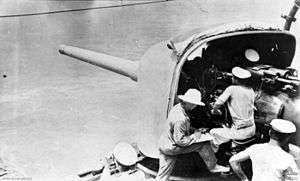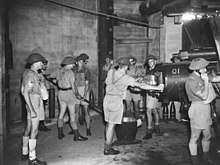BL 6-inch Mk XI naval gun
The BL 6-inch Mark XI naval gun[6] was a British 50 calibres high-velocity naval gun which was mounted as primary armament on cruisers and secondary armament on pre-dreadnought battleships from 1906 onwards.
| BL 6-inch Mk XI naval gun | |
|---|---|
 Gunnery exercise on HMAS Melbourne circa. 1913 | |
| Type | Naval gun Coast defence gun |
| Place of origin | United Kingdom |
| Service history | |
| In service | 1906 – 1957 |
| Wars | World War I World War II |
| Production history | |
| No. built | 177[1] |
| Variants | Mk XI |
| Specifications | |
| Mass | 19,237 lbs (8,726 kg)[2] |
| Barrel length | 300 inches (7.620 m) bore (50 cal) |
| Shell | 100 pounds (45.36 kg) Lyddite, Armour-piercing, Shrapnel[3] |
| Calibre | 6 inches (152.4 mm) |
| Muzzle velocity | 2,900 feet per second (884 m/s)[4] |
| Maximum firing range | 18,000 yards (16,000 m) @ 22.5°[5] |
History
The gun with its increased length of 50 calibres gave improved firepower over the current 6-inch Mk VII gun of 45 calibres. However, its increased length and weight made it unwieldy in the current manually operated shipboard mountings on light cruisers, which did not provide a steady platform. Britain reverted to 45-calibres guns in new warships from 1914 onwards with the BL 6-inch Mk XII gun. Of the 177 produced 126 remained for Royal Navy use in 1939.[7]
Naval gun
Guns were mounted in the following ships :
- The last 3 King Edward VII class battleships Britannia, Africa and Hibernia laid down 1902–1904
- Armoured cruisers: HMS Duke of Edinburgh and Black Prince laid down 1903
- Bristol class light cruisers laid down 1909
- Weymouth class cruisers laid down 1910
- Chatham class light cruisers laid down 1911
- Birmingham class light cruisers laid down 1912
- Monitor HMS Marshal Ney as re-gunned in 1918
Coast defence gun

The Mk XI gun was emplaced for coast defence in South Africa and particularly in Australia leading up to World War II, and remained in service until the 1950s. Guns in Australia came from the decommissioned World War I cruisers HMAS Sydney, HMAS Melbourne and HMAS Brisbane and were emplaced in northern Australia and Torres Strait to defend against possible attack by Japan,[8][9] and on Rottnest Island WA, Brisbane and the Sydney harbour[10] and Port Kembla[11] defences.
See also
Weapons of comparable role, performance and era
- 15 cm/50 41st Year Type : Imperial Japanese Navy equivalent gun
- 6"/50 caliber gun : US equivalent
Surviving examples

- RGF gun No. 2035 of 1905, and 1 other gun at Malgaskop, Saldanha Bay, South Africa
- VSM gun No. 2305 of 1912 formerly at Port Wakefield Proof Range, north of Adelaide, and since 2006 at B42 gun emplacement at Lower Georges Heights, Sydney Australia[12]
- A coast defence gun at East Point Military museum, Darwin, Australia
- One of the HMAS Sydney guns at Leighton Battery, Fremantle, Western Australia
- One of HMAS Melbourne's guns at the Fleet Air Arm Museum, Nowra, NSW, Australia
Notes
- Campbell, Naval Weapons of WWII, p.38.
- Campbell, Naval Weapons of WWII, p.38.
- 100 lb shells : Treatise on Ammunition, 1915
- 2900 ft/second : As quoted in "Range Tables for His Majesty's Fleet, 1910. February, 1911"; with 32 lb 1½ oz cordite MD size 26 propellant : Treatise on Ammunition, 1915
- 18,000 yards @ 22.5° elevation as coast defence gun, quoted by Spethman, 2008. Guns in naval use had lower elevation and hence shorter range.
- Mk XI = Mark 11, i.e. the eleventh model of BL 6-inch guns. Britain used Roman numerals to denote Marks (models) of ordnance until after World War II.
- Campbell, Naval Weapons of WWII, p.38.
- "Vanessa Seekee, "Artillery in Torres Strait 1891–1945: the silent forgotten sentinels of the north" in Memoirs of the Queensland Museum Cultural Heritage series, Volume 4 Part 1, November 2006" (PDF). Archived from the original (PDF) on 9 October 2008. Retrieved 10 December 2008.
- For photograph of gun at Emery Point, Darwin 1934 see ID Number: P02024.026 at Australian War Memorial photo archive Archived 5 January 2009 at the Wayback Machine
- For photograph of gun at Signal Hill 1946 see ID Number: 129982 at Australian War Memorial photo archive Archived 5 January 2009 at the Wayback Machine
- See The Diary and Journal of General Sir John G. N. Wilton, Royal Australian Army 1910–1977
- http://www.harbourtrust.gov.au/downloads/acrobat/media/mrcoastalgun.pdf
References
- David Spethman, "The Garrison Guns of Australia 1788 – 1962", published by Ron H Mortensen, Inala QLD 2008. ISBN 978-0-9775990-8-0
Bibliography
- Campbell, John (1985). Naval Weapons of World War Two. Naval Institute Press. ISBN 0-87021-459-4.
External links
| Wikimedia Commons has media related to BL 6 inch Mk XI naval gun. |
- Tony DiGiulian, British 6"/50 (15.2 cm) BL Marks XI and XI*